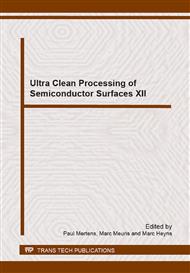p.119
p.125
p.128
p.131
p.134
p.138
p.143
p.148
p.153
Physical Chemistry of Water Droplets in Wafer Cleaning with Low Water Use
Abstract:
Reduction of water and energy consumption is of importance for keeping viable industry in Europe. In 2012 the Eniac project Silver was started in order to reduce water and energy consumption in the semiconductor industry by 10% [1]. Cleaning of wafers is one of the key process steps that require a high volume of Ultra-Pure Water (UPW). For the production of a single wafer more than 120 cleaning steps may be required [2]. Furthermore, the reduction of the feature size makes devices more vulnerable to damage by mechanical action. This trend gives rise to the need for new, gentler cleaning processes.
Info:
Periodical:
Pages:
134-137
Citation:
Online since:
September 2014
Keywords:
Price:
Сopyright:
© 2015 Trans Tech Publications Ltd. All Rights Reserved
Share:
Citation:


